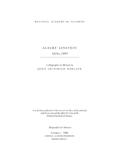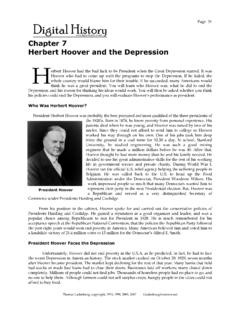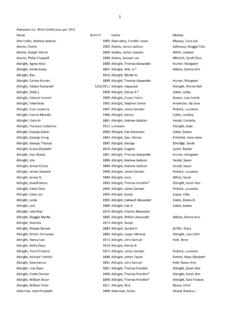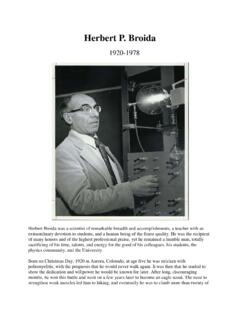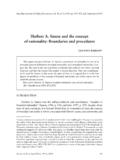Transcription of HERBERT FRIEDMAN 1916–2000 - National Academy of Sciences
1 National Academy OF SCIENCESHERBERT FRIEDMAN1916 2000A Biographical Memoir byHERBERT GURSKYAny opinions expressed in this memoir are those of the authorand do not necessarily reflect the views of theNational Academy of Sciences . Biographical Memoirs, VOLUME 88 PUBLISHED 2006 National Academy OF SCIENCESWASHINGTON, FRIEDMANJune 21, 1916 September 9, 2000BY HERBERT GURSKY IF I WERE RICH, I would pay for the privilege of doing it, Gertrude FRIEDMAN quoted her husband as saying of thedecades of research he had carried out. She was reminisc-ing of their life together in their home of 50 years in Ar-lington, Virginia. The house is well known to friends of theFriedmans, where each spring they hosted a Sunday brunchwhen the azaleas that overflowed their front yard were atpeak bloom.
2 FRIEDMAN died there of cancer on September9, 2000 , at the age of FRIEDMAN spent nearly his entire professionalcareer at the Naval Research Laboratory in Washington, , after arriving there in 1940 upon completion of hisgraduate work at Johns Hopkins University. At the NRL hehad a very successful career applying X-ray analysis to thestudy of materials. He then pioneered the application ofsounding rockets to solar physics, aeronomy, and in his life he served as a statesman and public advo-cate for science. FRIEDMAN retired from the Naval ResearchLaboratory in 1980 but maintained an active associationwith the laboratory and the scientific community until hisdeath.
3 In 1996, on the occasion of his eightieth birthday,he received the NRL Lifetime Achievement Award and was4 BIOGRAPHICAL MEMOIRS named Chief Scientist Emeritus of the Hulburt Center. TheFriedman Room at NRL remains as a memory of his careerand stature as a was born in Brooklyn on June 21, 1916, thesecond of three children of Samuel and Rebecca father ran a successful art-framing store on Ninth Streetin Manhattan. An Orthodox Jew who closed his business onSaturday, Samuel FRIEDMAN was born in Evansville, Indiana,in 1877 and moved to New York City as a young man. Rebeccawas born in Eastern Europe. HERBERT grew up as an aspir-ing artist and developed sufficient skill as a young man toearn pocket money from the sale of his sketches.
4 He en-tered Brooklyn College in 1932 as an art major but finishedwith a degree in FRIEDMAN recalls no special interest in sciencein the FRIEDMAN family. The family environment was fo-cused on the humanities, especially art and music. In anautobiographical note, as an example of an interest in sci-ence, FRIEDMAN mentions only having traveled to upperManhattan in 1925 when he was nine years old to observe atotal eclipse of the sun, although he did admit an interestin mathematics. No one else in the FRIEDMAN family devel-oped any special skills as an artist, even though SamuelFriedman developed close associations with artists as partof his business.
5 So it was something special about Fried-man, developed at an early age, that led him to focus hisenergy so successfully, first on art, then on completing his undergraduate education, Fried-man had no thought of continuing his studies, but it wasstill the depression and jobs were scarce. The best he mightexpect was teaching in a secondary school, but such posi-tions were highly competitive. He did manage to find workas a commercial artist for five dollars a week. With suchdim prospects he decided to go on to graduate school. His5 HERBERT FRIEDMANB rooklyn College mentor, Bernhardt Kurrelmeyer, helpedhim obtain a scholarship to Johns Hopkins University, wherehe was given an instructor s position for $40 a FRIEDMAN began his graduate studies in 1936, sci-ence in the United States was in the midst of an explosionin basic physics research.
6 Compton in Chicago and Millikanin Berkeley were studying the very energetic particles com-prising cosmic rays; Anderson in Pasadena had discoveredthe positive electron, confirming one of the more bizarrepredictions of quantum mechanics, and Lawrence in Ber-keley was building cyclotrons for smashing atoms. Hubblein Pasadena had discovered the recession of galaxies, lead-ing to the concept of the expanding universe. However, thebread and butter of physics was materials research. Discov-eries early in the century by Rutherford and Bohr led tothe modern concept of the atom. Quantum mechanics, com-bined with powerful new diagnostic techniques, such as thedevelopment of X-ray technology and X-ray diffraction, ledto a whole industry dedicated to understanding the struc-ture of materials, picking up where the chemists had Johns Hopkins, FRIEDMAN conducted his thesis re-search under the direction of J.
7 A. Bearden, an expert inthe exploitation of X rays to study material. Bearden, amaster experimenter, had built a new instrument for study-ing X rays using their Bragg reflection characteristics. Todetect the X rays, Bearden used an ionization developed a Geiger counter as the instrument sdetector, which greatly improved its sensitivity. The devicehad been invented only in 1928 and was just coming intogeneral use. There is a fundamental difference between anionization chamber and a Geiger counter, even though theyare close cousins. With an ionization chamber, the exceed-ingly small current resulting from the interactions of X rays6 BIOGRAPHICAL MEMOIRSis recorded.
8 In a Geiger counter the charge resulting fromeach X-ray photon is amplified in the gas, collected as apulse, and counted as a single event, allowing for long mea-surement periods. FRIEDMAN used this instrument for histhesis work and wrote three papers studying X-ray interac-tions with materials, mostly was unable to find a position when he fin-ished at Hopkins in 1939, so he remained at the universityfor a year as an instructor. In 1940 he was offered a posi-tion in the Metallurgy Department at NRL, but only afterthe intercession of the Hopkins Physics Department chair,who was apparently outraged that a Hopkins graduate wouldhave difficulty finding a was still a small place, not yet swelled by wartimeactivities.
9 The institution comprised no more than about100 scientists and engineers, spread over seven researchdepartments. The titles of his papers during the 1940s re-veal the applied nature of his work and included LeadMarking of Radiographic Films and Its Prevention, Thick-ness Measurements of Thin Coatings by X-Ray Absorption, and Determination of Tetraethyl Lead in Gasoline by X-Ray Absorption. During this time he also applied for hisfirst of eventually 50 patents, A Parallel Arrangement ofGM (Geiger-Mueller) Counters. In 1942, because of dissat-isfaction with changes in management of his research area,he verged on accepting a position at the National Bureauof Standards.
10 Learning of this, E. O. Hulburt offered Fried-man a position in his own Optics Division at NRL as thehead of a newly formed section dedicated to exploiting elec-tron microscopy and X-ray diffraction analysis. Friedmanwas still only 26 years this time FRIEDMAN married Gertrude was also from Brooklyn; in fact, the two had attendedBrooklyn College at the same time without ever FRIEDMANH erbert s sister, who was Gertrude s close friend, introducedthe two in 1938. The FRIEDMAN children, Paul and Jon,were born in 1944 and 1947, respectively, and the familymoved into their Arlington home in 1945 FRIEDMAN received the Navy s Distinguished Ci-vilian Service Award for his wartime development of a tech-nique for cutting and tuning RF crystals for radios by usingtheir Bragg reflection characteristics.
